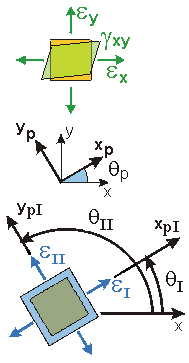|
» Principal Strains
PRINCIPAL STRAINS are
the Maximum and Minimum Normal Strains that occur at a point
as the set of axes is rotated by a certain angle qp.
The Principal Strains are called eI
and eII,
and occur along the xp-yp axes. These directions
are NOT necessarily the same as those for the Principal Stresses for a
given stress-state.
The Principal Strains for a given strain state are given by:
|
eI
=
|
ex
+ ey

2
|
+
|
|
|
ex
 ey ey

2
|
|
2
|
+
|
|
gxy

2
|
|
2
|
|
1/2
|
|
eII
=
|
ex
+ ey

2
|
-
|
|
|
ex
 ey ey

2
|
|
2
|
+
|
|
gxy

2
|
|
2
|
|
1/2
|
|
- The Principal Strains occur when the element has been rotated by an
angle of qp, where:
|
tan(2qp)
=
|
gxy

ex - ey
|
|
As with the angles for Principal Stresses, there are two solutions.
- KEY POINT: When the Normal Strains are Principal Strains the
Shear Strain is Zero.
|










